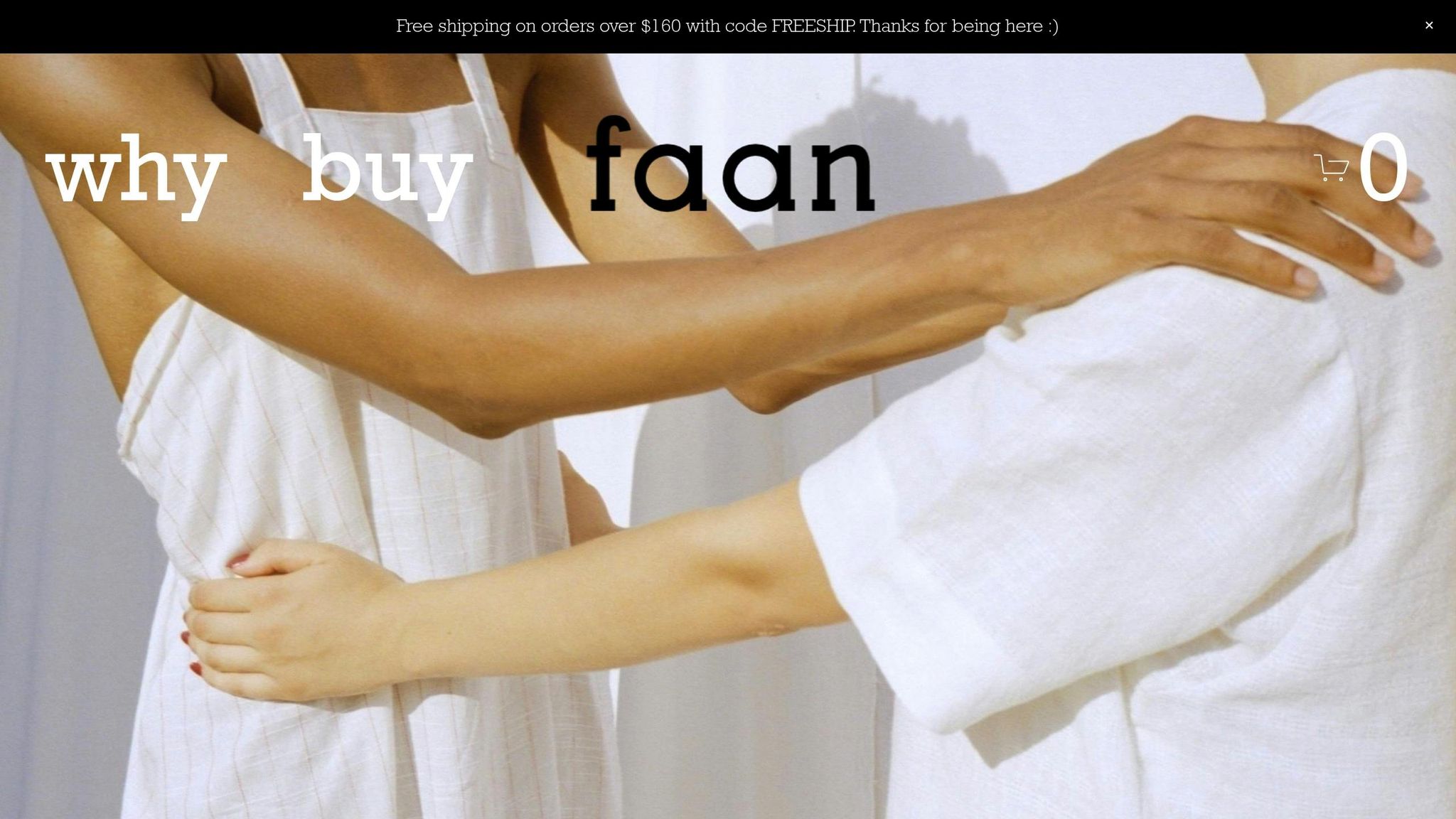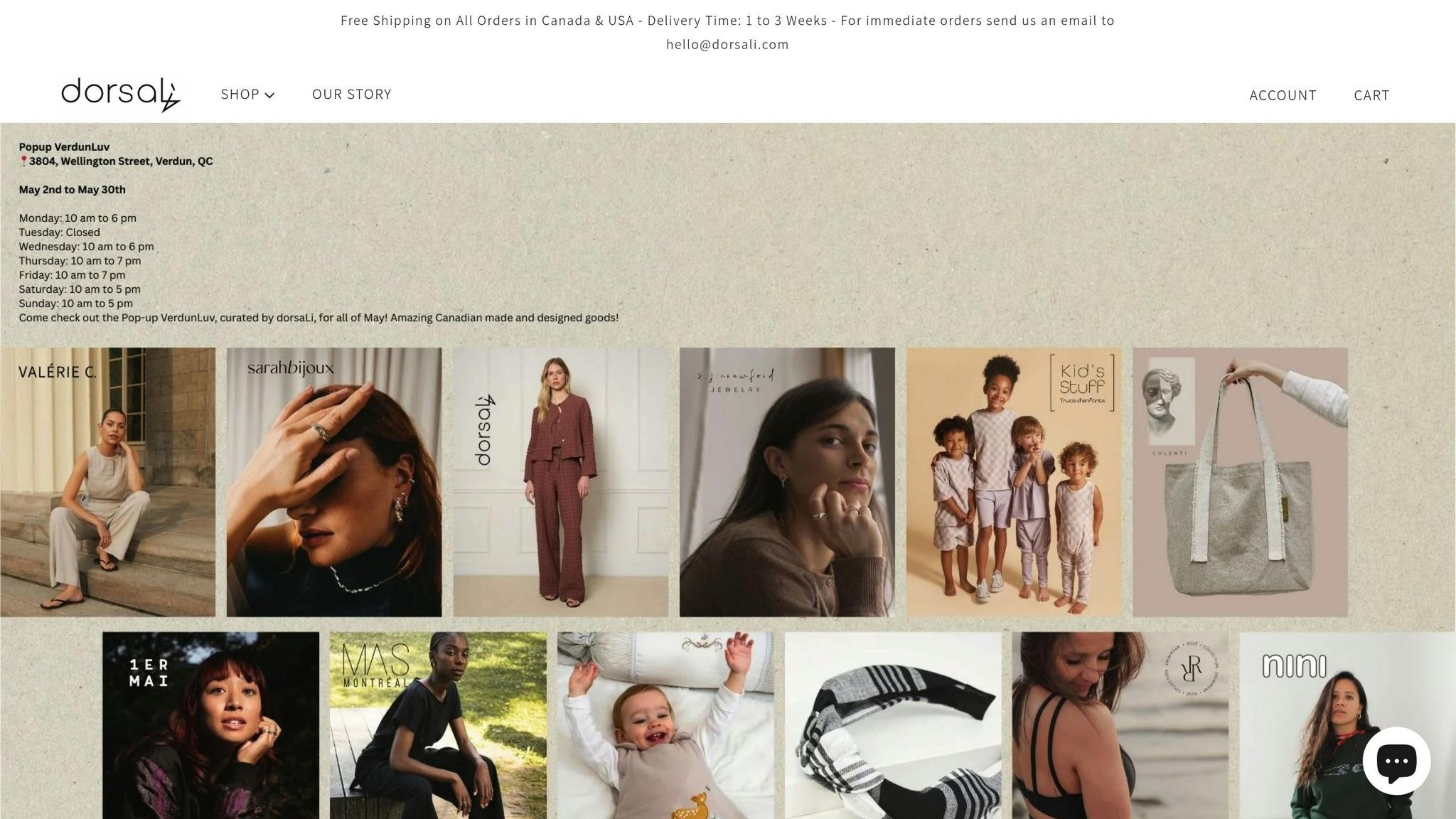How Slow Fashion Boosts Local Economies
Slow fashion isn’t just about better clothes - it’s about stronger communities. Unlike fast fashion, which prioritizes cheap production overseas, slow fashion focuses on local manufacturing, fair labor, and durable designs. This approach keeps money in local economies, creates jobs, and preserves craft skills.
Key Benefits of Slow Fashion:
- Local Job Creation: Supports roles in design, production, and repair.
- Stronger Local Supply Chains: Keeps money circulating within communities.
- Craft Preservation: Protects traditional skills and heritage.
- Lower Environmental Impact: Reduces waste and pollution.
Quick Comparison:
| Fast Fashion | Slow Fashion |
|---|---|
| High volume, low-cost production | Lower volume, higher quality focus |
| Outsourced labor overseas | Local manufacturing and ethical production |
| Encourages overconsumption | Promotes mindful purchasing |
| Large environmental footprint | Reduces waste and emissions |
Growing a Local Economy for Fashion: Discussion with Faanware and Esperanza Threads

How Fast Fashion Hurts Local Economies
Fast fashion's relentless drive for cheap production has reshaped American manufacturing, leading to factory closures and job losses. By prioritizing overseas production, this global supply chain model has inflicted economic harm that extends beyond the immediate loss of jobs.
Lost Jobs and Shuttered Factories
The numbers paint a grim picture. Between January 2005 and January 2020, U.S. textile manufacturing jobs dropped by 44.3%, while apparel manufacturing jobs plummeted by 59.3% [5]. Entire communities have felt the impact as factories, once the backbone of local economies, shut their doors. From 1990 to 2012, the U.S. textile and garment industry shed 1.2 million jobs [6], largely due to brands chasing cheaper production overseas. The COVID-19 pandemic only worsened the situation, with over 83,700 jobs lost in the U.S. textile and apparel sector between March and April 2020 [5].
The closures of iconic brands' facilities underscore this trend. In 1997, Levi Strauss closed 11 plants across North America, followed by another 11 in 1998, leaving 16,310 workers unemployed [6]. Similarly, Vans transitioned to overseas production in the 1990s, shutting down its U.S. facility in 1995. While this shift boosted Vans' revenue from $2.7 million in 1993 to $88 million in 1995, it came at the expense of American jobs [6]. The economic fallout is clear: the U.S. textile and apparel manufacturing sector’s share of GDP dropped from 0.57% in 1998 to just 0.13% in 2019 [5].
The consequences extend beyond job losses, stripping local economies of vital financial resources.
Economic Drain on Communities
Fast fashion’s global operations siphon money away from local communities. In 2019, the U.S. apparel trade deficit hit $80.6 billion [5], representing billions of dollars that could have bolstered domestic production but instead flowed overseas. The imbalance is stark: in 2017, U.S. apparel exports amounted to $5.7 billion, while imports soared to $82.6 billion [6].
"To be competitive, offshore factories will often cut corners on these infrastructure and management system costs" [6].
The damage doesn’t stop at lost jobs or trade imbalances. Fast fashion’s disposable nature adds another layer of economic strain. Communities bear the burden of managing waste from discarded clothing, with the annual value of prematurely discarded items exceeding $400 billion globally [7]. While fast fashion retailers enjoy profits from mass production and economies of scale, these gains often enrich corporate shareholders and executives, leaving local economies to grapple with widening inequality and reduced financial stability.
How Slow Fashion Builds Stronger Local Economies
Slow fashion shifts the focus of economic activity back to local communities by emphasizing nearby production and consumption. By keeping manufacturing and spending close to home, this approach ensures that profits remain within the community, creating a ripple effect that strengthens local economies.
This model transforms fashion into a tool for regional economic growth, keeping money circulating locally and fostering more resilient economies. Let’s take a closer look at how slow fashion achieves this through job creation and localized supply chains.
Creating Jobs and Preserving Craft Skills
Slow fashion supports local job creation across various roles, including design, production, retail, and even repair services. It goes beyond traditional manufacturing by opening opportunities in areas like pattern making, small-batch production management, marketing, and more [3]. These localized operations not only create employment but also help preserve traditional craft skills, ensuring they are passed down to future generations.
Brands that employ local artisans contribute significantly to both job creation and the preservation of heritage skills. For instance, Adelante works with craftsmen in Guatemala, paying them nearly twice the local market rate, enabling workers to support their families and reinvest in their communities [9]. Similarly, Alabama Chanin collaborates with artisans in Alabama to handcraft garments using a mix of traditional and modern techniques. Good Earth in India partners with local artisans to highlight textile traditions like handloom weaving and block printing [11].
Small and medium enterprises (SMEs) are at the heart of the slow fashion movement. In the UK, for example, SMEs make up 40% of the fashion industry [10]. These smaller-scale operations, which prioritize quality and local production, play a vital role in strengthening community networks.
By creating diverse job opportunities and preserving traditional skills, slow fashion lays the foundation for localized supply chains that further enhance community wealth.
Local Supply Chains Keep Money in Communities
Slow fashion brands that prioritize local sourcing and manufacturing amplify economic benefits within their communities. When money is spent on locally made products, it stays within the region, supporting jobs and small businesses. This multiplier effect means that each dollar spent locally generates additional economic activity [3].
Localized supply chains also reduce transportation costs and environmental impact while building regional expertise in textile production. For example, when a brand sources cotton from local farms, processes it at nearby mills, and works with local artisans to assemble garments, every step strengthens the local economy. This approach fosters closer relationships between producers and consumers, building trust and encouraging repeat business [3].
| Economic Benefit | How It Works | Result |
|---|---|---|
| Increased Local Employment | Jobs in production, design, repair, and retail | A more stable local job market |
| Enhanced Community Wealth | Value retained within local supply chains | Money circulates within the community |
| Skill & Knowledge Retention | Preservation of traditional crafts and expertise | Cultural heritage becomes an economic asset |
| Supply Chain Resilience | Reduced reliance on global networks | Lower vulnerability to external shocks |
Additionally, strong local networks of skilled producers and retailers create lasting community bonds. These networks encourage the ongoing exchange of skills, resources, and information, which drives further economic activity [3]. The rise of second-hand and rental markets, now nearing $33 billion in annual sales [10], also offers new opportunities for local economies. Businesses like repair shops, consignment stores, and clothing rental services extend the life of garments while keeping money circulating locally.
How Ethical Brands Support Local Economies
Ethical fashion brands prove that businesses can thrive while prioritizing community well-being. By focusing on local production and fair labor practices, these brands not only ensure ethical standards but also contribute significantly to the economic vitality of their communities. Producing goods closer to home allows for better oversight of working conditions and fosters trust among customers who value openness and accountability. This approach blends ethical responsibility with real economic gains.
DorsaLi's Local Manufacturing Approach

DorsaLi is a shining example of how an ethical brand can make a meaningful impact on local economies. Headquartered in Montreal, the company keeps its manufacturing operations in-house, ensuring that jobs stay within Canada rather than being outsourced to overseas factories. This decision helps keep labor spending within the local economy, benefiting the community directly.
Additionally, DorsaLi is committed to preserving traditional craftsmanship. By employing local artisans, the brand safeguards skills in tailoring and garment construction that might otherwise be lost.
"Sustainable fashion redefines the fashion industry, championing eco-friendly materials and ethical labor practices." – Johnny Bailey, Founder, Planet Pristine [12]
The company also creates diverse job opportunities in areas like design, quality control, and customer service. These roles cater to varying skill levels and offer pathways for career growth, further enriching the local workforce.
This emphasis on local manufacturing is often paired with sustainable sourcing, amplifying the economic benefits for communities.
Combining Responsibility with Economic Benefits
Brands like DorsaLi show that responsible sourcing can significantly boost local economies. By prioritizing eco-conscious materials and ethical labor standards, these companies frequently partner with local suppliers who share similar values. This not only strengthens regional businesses but also builds lasting economic relationships.
For instance, when brands source organic cotton or natural dyes from nearby farmers, they provide steady income to agricultural enterprises. This creates ripple effects throughout the supply chain, supporting entire communities [2]. Local sourcing also cuts down on transportation costs and emissions, while fostering regional expertise in sustainable textile production [3]. As communities develop specialized skills in these areas, they become increasingly attractive to other ethical brands.
Beyond creating jobs, ethical brands invest in worker training and skill development. By offering fair wages and safe working environments [2], workers gain more disposable income, which they often reinvest in their communities, further stimulating economic growth.
| Impact Area | How Ethical Brands Help | Community Benefit |
|---|---|---|
| Employment | Provide jobs in design and production | Stable income for families |
| Skills | Offer worker training programs | Strengthened workforce capabilities |
| Supply Chain | Partner with local suppliers | Boosted regional businesses |
| Spending | Pay fair wages | Increased local economic activity |
Ethical brands also attract consumers who are willing to pay a premium for quality and responsibility. This consumer behavior circulates additional revenue within local economies and sets an example for sustainable business practices across various industries.
sbb-itb-9137a7f
Additional Economic and Social Benefits of Slow Fashion
Slow fashion offers more than just ethical shopping choices - it brings lasting economic and social value to communities. Beyond creating jobs and boosting local economies, it helps build stronger financial and cultural foundations that benefit everyone involved.
Lower Environmental Impact
By focusing on sustainable materials and reducing waste, slow fashion significantly cuts environmental costs. For instance, organic cotton releases up to 46% less CO2 compared to conventional cotton. Plus, simply doubling the lifespan of a garment can slash greenhouse gas emissions by 44%[4]. Another major win? It reduces strain on water systems. Textile dyeing alone accounts for about 20% of global wastewater[1]. These eco-conscious practices not only protect the planet but also enhance the overall well-being of communities that embrace them.
Strengthening Community Identity and Driving Tourism
Slow fashion has a unique way of weaving cultural identity into its fabric, attracting both visitors and investors. Communities that celebrate their heritage and craftsmanship create meaningful connections with tourists, often leading to repeat visits and glowing recommendations[13]. Take Damascus, Virginia, for example. Known as "Trail Town USA", it has revitalized itself through outdoor tourism. Similarly, Lewisburg, West Virginia, has transformed its downtown into an arts hub, while Florida's Space Coast supports local boutiques and eco-fashion events[8][13]. These efforts fuel local economies by boosting spending on accommodations, dining, and transportation. At the same time, they preserve traditional textile crafts, creating new opportunities for artisans and ensuring that these skills endure for future generations.
Conclusion: How Slow Fashion Changes Local Economies
Slow fashion moves away from the fast fashion model of mass production and waste, focusing instead on strengthening local communities. This shift brings lasting economic advantages by keeping money circulating within local economies, preserving traditional craftsmanship, and creating stable jobs that are harder to outsource.
When brands like dorsaLi choose to design and produce their clothing in Canada, the local economy feels the impact directly. Every dollar spent on locally made garments supports a network of textile artisans, seamstresses, tailors, and retailers - key players in the fashion supply chain. This ensures that a larger share of each product's value stays within the community where it was made, creating a ripple effect of economic benefits.
Slow fashion also helps preserve traditional textile skills, passing them down through generations. By choosing brands that prioritize local sourcing and production, consumers are investing in the knowledge and craftsmanship that keep communities vibrant and self-reliant. This sustained support builds a strong economic foundation that can weather changes over time.
The benefits extend beyond economics. Slow fashion fosters stronger community connections through trust, collaboration, and shared values among designers, producers, suppliers, and consumers. These relationships create social capital, which in turn fuels continued growth and innovation in local fashion ecosystems.
By supporting local designers, artisans, and manufacturers who are committed to their communities, you can make a difference. Opting for brands that emphasize transparent supply chains, fair labor practices, and environmentally conscious materials - and choosing fewer, higher-quality garments that stand the test of time - helps create a more sustainable and equitable future for local economies everywhere.
Ultimately, the choice between fast and slow fashion goes beyond personal style or environmental concerns. It’s about deciding which kind of economic future you want to support: one that drains value from communities or one that uplifts and strengthens them from within.
FAQs
How does slow fashion help preserve traditional craftsmanship in local communities?
Slow fashion is deeply connected to preserving traditional craftsmanship, putting a spotlight on artisanal skills and ethical production methods. By championing techniques that have been handed down through generations, it ensures these age-old practices remain relevant and continue to thrive. Handcrafted, high-quality goods become more than just products - they represent a commitment to cultural heritage and a celebration of local artistry.
Beyond craftsmanship, slow fashion emphasizes fair wages and safe working conditions, giving artisans the opportunity to sustain their work and pass it on to future generations. This approach not only boosts local economies but also strengthens the cultural fabric of communities, leaving a meaningful and lasting legacy.
How does slow fashion benefit local economies?
The Economic Impact of Slow Fashion on Local Communities
Slow fashion offers tangible benefits to local economies by embracing ethical and sustainable practices. By prioritizing local production and sourcing, it directly supports small businesses, skilled artisans, and manufacturers. This approach not only creates jobs but also helps preserve traditional craftsmanship that might otherwise disappear. The result? Money stays within the community, boosting local economies and building financial resilience.
Another key aspect of slow fashion is its commitment to fair wages and safe working environments. This focus improves the quality of life for workers and contributes to the long-term well-being of entire communities. When you choose locally made, high-quality clothing, you're doing more than purchasing an outfit - you’re actively supporting a healthier, more sustainable local economy.
How can supporting slow fashion help strengthen local economies?
How Slow Fashion Supports Your Local Economy
Buying into slow fashion isn’t just about what you wear - it’s about where your money goes. When you shop from local designers, artisans, and manufacturers who prioritize ethical practices, you’re directly contributing to job creation and keeping money flowing within your community. This approach not only strengthens the local economy but also helps preserve traditional skills and craftsmanship that might otherwise fade away.
Slow fashion also aligns with eco-conscious values. Many local brands focus on using environmentally friendly materials and cut down on transportation emissions by sourcing and producing locally. By choosing fewer, well-made pieces over mass-produced fast fashion, you’re backing a more thoughtful and community-driven way of doing business. Every purchase you make becomes a step toward building a stronger, more resilient local economy.


Commentaires